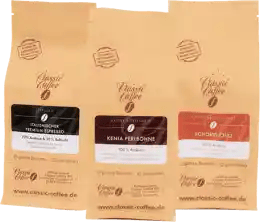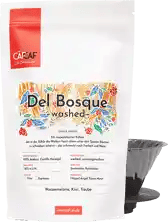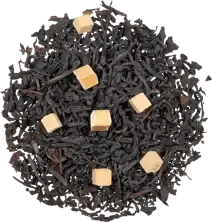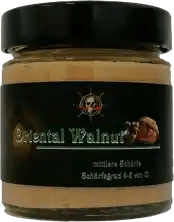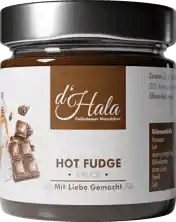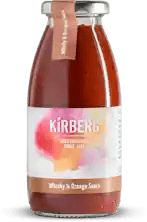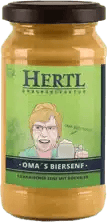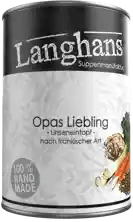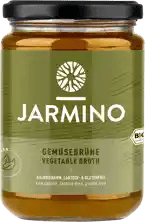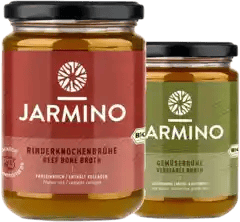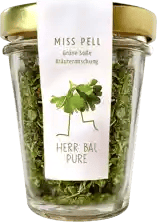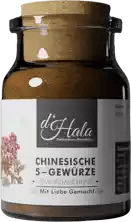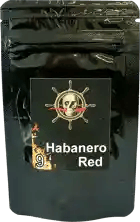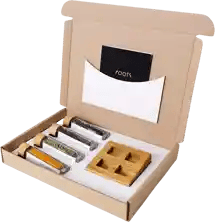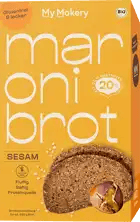Quality instead of quantity!
7,000 independent products
No mainstream
7,000 independent products
The world of sauces - buying sauces away from the mainstream
Welcome to the fascinating world of sauces! They are more than just garnishes; sauces can completely transform a dish, adding depth, moisture and unparalleled flavor. From simple, everyday sauces to sophisticated gourmet creations, sauces are an indispensable part of the culinary arts.
What are sauces actually?
Sauces are liquid or semi-liquid mixtures that are used to add flavor, moisture and visual appeal to dishes. They can be prepared in a variety of ways - cooked, emulsified, fermented or raw - and consist of a wide range of ingredients such as fat, stock, dairy products, vegetables, herbs and spices.
The role of sauces in the culinary arts
Sauces play a central role in the kitchen. They help to combine the individual components of a dish and ensure a balanced taste experience. A good sauce can turn a simple dish into a culinary highlight. They often reflect the culture and traditions of the region from which they originate and are an expression of the chef's creativity.
Different types of sauces
The variety of sauces is enormous and ranges from the basic sauces of French cuisine to exotic creations from all over the world. Each sauce has its own character and use, which makes it an exciting element in the kitchen.
Classic sauces of French cuisine
French cuisine is known for its classic "mother" sauces: béchamel, velouté, espagnole, hollandaise sauce and tomato sauce. These sauces form the basis for a variety of derivatives and are an essential part of traditional French cuisine.
Béchamel, one of the best-known mother sauces, is a white sauce made from butter, flour and milk. It serves as the base for many other sauces and dishes such as lasagne or moussaka. Its velvety texture and smooth taste make it a versatile favorite in the kitchen.
Velouté is another important mother sauce that consists of a light broth (chicken, veal or fish) and a roux. This sauce serves as the basis for a number of variations by adding cream, wine or herbs.
Espagnole sauce, also known as a basic brown sauce, is made from beef stock, tomatoes, roasted vegetables and a dark roux. It is rich and complex in taste and forms the basis for many hearty dishes and gravies.
Hollandaise sauce is famous for its rich, buttery consistency and slightly sour taste. It is made from egg yolk, butter and lemon juice or white wine vinegar and is a classic accompaniment to asparagus or Eggs Benedict.
Finally, tomato sauce is a versatile sauce made from tomatoes, vegetables and herbs. It is the basis for numerous dishes, from pasta to ratatouille and pizza.
These classic French sauces are not only a testament to the sophistication and depth of French cuisine, but also an essential part of basic culinary training. They teach techniques that every ambitious chef should master and offer an insight into the art and science of cooking.
Popular international sauces
There is a wealth of popular sauces around the world, often closely associated with local cuisine. Italian tomato sauce, Indian curry sauces, Chinese soy sauce and Mexican salsa are just a few examples of sauces that have achieved international fame.
Modern sauces and trends
In modern cuisine, traditional sauces are often reinterpreted or enriched with innovative ingredients. Fusion sauces, which combine elements of different cuisines, and sauces with unusual ingredients such as superfoods or exotic spices are current trends in gastronomy.
Sauces and their ingredients
The basis of every sauce is its ingredients. These not only determine the taste, but also the consistency and color of the sauce. From the simplest to the most complex, the choice and combination of ingredients is crucial for the end product.
Basic ingredients for homemade sauces
The basic ingredients for many sauces include fat (such as oil or butter), a source of acid (such as vinegar or lemon juice), a liquid (such as stock, wine or milk) and flavoring agents such as herbs, spices or vegetables. The type of ingredients and their ratio to each other determine the type of sauce.
Seasoning and refining sauces
Sauces are refined by adding spices, herbs or other flavoring ingredients. Spices such as pepper, paprika or nutmeg and fresh herbs such as basil or thyme are popular. Ingredients such as mustard, capers or olives can also enrich a sauce.
Seasoning is an important step in the preparation of a sauce. The aim is to achieve a balance between the different flavors and to match the sauce perfectly to the dish.
Vegan and vegetarian alternatives
There are numerous alternatives to traditional sauces in vegan and vegetarian cuisine. Vegetable fats, nut milk or vegetable stock are used instead of animal products. Soy sauce, tahini or plant-based cream are popular base ingredients for vegan sauces.
The challenge is to adjust the consistency and taste of the sauce so that it is in no way inferior to the traditional versions. Spices and fresh herbs also play an important role here to achieve depth and complexity.
Homemade sauces - tips and tricks
Homemade sauces are often a highlight in any dish. They offer the opportunity to experiment with flavors and refine dishes individually. With a few tips and tricks, anyone can learn how to make delicious sauces at home.
Basic recipes for beginners
For beginners in sauce making, simple recipes such as a simple tomato sauce, a simple white wine sauce or a classic gravy are ideal. These basic recipes only require a few ingredients and steps, but are still tasty and versatile.
It is important to understand the techniques of sauce cooking, such as sautéing onions and garlic in fat, thickening with flour or reducing liquids to achieve more intense flavors.
Common mistakes and how to avoid them
A common mistake when preparing sauces is burning the base ingredients. To avoid this, you should sauté the ingredients over a medium heat, stirring constantly. Over-seasoning a sauce is also a common mistake; it is better to season gradually and taste regularly.
Another tip is not to thicken sauces too much. A good sauce should have the right consistency to blend well with the dish, but not be so thick that it seems heavy or sticky.
Creative ideas for your own sauce creations
The beauty of sauces is their versatility. You can experiment by combining different ingredients and spices to create your own signature sauce. Try adding fruit for a sweet touch, or add some heat with chilies or pepper.
Inspiration can come from different cuisines around the world. Experiment with Asian, Mediterranean or Latin American influences to take your dishes to the next level.
The history of sauces
Sauces have a rich and varied history that is deeply rooted in the world's culinary traditions. Their development reflects the cultural, geographical and historical influences of the regions from which they originate.
Origins and development
The first sauces probably arose from the need to preserve food and improve its taste. In ancient times, sauces were made from fish, salt and spices to enhance the flavor of food and prolong its freshness. In the Middle Ages, European cuisines began to develop sauces that were rich in spices and herbs and served to mask the taste of often less fresh meat.
With the discovery of new worlds and the introduction of exotic spices and ingredients to Europe, sauces underwent a remarkable development. French cuisine played a leading role in the refinement of sauces, making them an indispensable part of fine dining.
Famous sauces and their stories
Many sauces have interesting origins and histories. Worcestershire sauce, for example, was invented in England in the 19th century when a nobleman from India brought back a recipe for an Indian sauce. The famous Tabasco sauce was created in Louisiana, USA, in the 19th century and quickly became a symbol for hot sauces worldwide.
In Asia, sauces such as soy sauce and fish sauce have a history dating back thousands of years and are closely linked to the culinary traditions of the region. These sauces are an essential part of local cuisine and have had a significant influence on international cuisine.
Sauces in modern cuisine
Sauces remain an essential part of modern cuisine and offer endless possibilities for flavor enhancement and creative expression. They adapt to changing tastes and trends while remaining a timeless element in the culinary world.
Sauces in the gourmet kitchen
In gourmet cuisine, sauces are prized for their ability to enhance dishes and turn them into an unforgettable experience. They are often made using fine techniques and high-quality ingredients and are a sign of the chef's skill and creativity.
New trends in gourmet cuisine include the use of fermented or smoked ingredients in sauces to add depth and complexity, as well as experimenting with unusual flavor combinations.
Sauces in everyday cooking
Sauces also play an important role in everyday cooking. They help to create quick and delicious dishes and are an easy way to add a touch of sophistication to everyday dishes. From a quick tomato sauce to homemade mayonnaise, sauces are an integral part of everyday cooking routines.
The availability of high-quality ready-made sauces has also made it easier to incorporate a variety of flavors into home cooking without having to spend a lot of time preparing them.
Future trends in sauces
The future of sauces looks exciting. With a growing interest in global cuisines and an increased emphasis on health and sustainability, sauces are evolving. Plant-based and health-promoting sauces containing superfoods and alternative ingredients are gaining popularity.
Technology is also influencing the way sauces are made and presented. From the use of molecular cooking techniques to sustainable production methods, the world of sauces is constantly evolving.
Storing and serving sauces correctly
Storing and serving sauces correctly is crucial to preserving their quality and flavor. A well stored and presented sauce can elevate a dish to a new level.
Storage tips
Sauces should always be stored in a cool, dark and airtight place. Homemade sauces should be kept in the fridge and used within a few days. Industrially produced sauces often have a longer shelf life, but they should also be refrigerated after opening. Be careful not to store sauces next to strong-smelling foods to avoid flavor transfer.
The art of dressing sauces
Serving sauces is about more than just taste - it's also about presentation. A beautifully presented sauce can be a visual highlight and whet the appetite. For a professional look, you can either arrange sauces directly on the plate or serve them in a separate sauce boat. Experiment with different techniques such as drizzling or dabbing to make your dishes visually appealing.
Health aspects of sauces
Sauces can not only enrich the taste of a dish, but also influence its nutritional values. It is important to consider the health aspects of sauces, especially when it comes to fat, sugar and salt content.
Nutritional values and health considerations
Many traditional sauces can be high in fat, sugar or salt. However, modern recipes strive to create healthier versions by using alternative ingredients such as vegetable oils, natural sweeteners or spices to enhance flavor. It is always advisable to check the ingredients list of ready-made sauces and, where possible, prefer homemade options.
When making sauces at home, you can maintain control over the ingredients used and ensure they meet your dietary requirements. Using fresh ingredients and minimizing artificial additives can help to make your diet more balanced and healthy.
Healthy sauce alternatives
There are numerous alternatives to traditional, rich sauces for a healthier diet. Sauces based on yogurt, avocado or tomatoes are not only delicious, but also rich in nutrients. Herbs and spices can be used to enhance the flavor without adding extra calories.
Vegan and vegetarian sauce options that utilize plant-based proteins and fats are also on the rise. These alternatives not only offer health benefits, but also contribute to a more sustainable diet.
Fascinating sauces from around the world
The culinary world of sauces is incredibly diverse and offers an insight into the flavors of different cultures. Each region of the world has its own characteristic sauces that tell stories about the local cuisine and traditions.
Sauces in different cultures
In every culture, there are sauces that are considered culinary heritage. In Italy, for example, tomato sauces and pesto are deeply rooted in the national cuisine. In Mexico, the variety of salsas is an expression of regional differences and ingredients. In Japan, on the other hand, teriyaki sauce plays an important role and gives many dishes their characteristic taste.
These sauces are not only an integral part of local cuisine, but have also gained worldwide recognition and become part of the global culinary landscape.
Exotic and unusual sauces
Away from the well-known classics, there is a world of exotic and unusual sauces to discover. From the Ethiopian Berbere sauce, which uses a mixture of spices, to the South Korean Gochujang, a spicy and fermented paste, these sauces offer unique taste experiences.
Exploring these sauces is a journey for the taste buds and an opportunity to broaden your culinary horizons. They invite you to discover new ingredients, flavors and preparation methods and to be inspired by the culinary traditions of the world.
Brilliant!

Bitte bestätige deine Anmeldung noch eben - du hast eine Bestätigungsmail von uns. Klicke darin auf den Link. Danach bekommst du deinen Rabattgutschein.























































